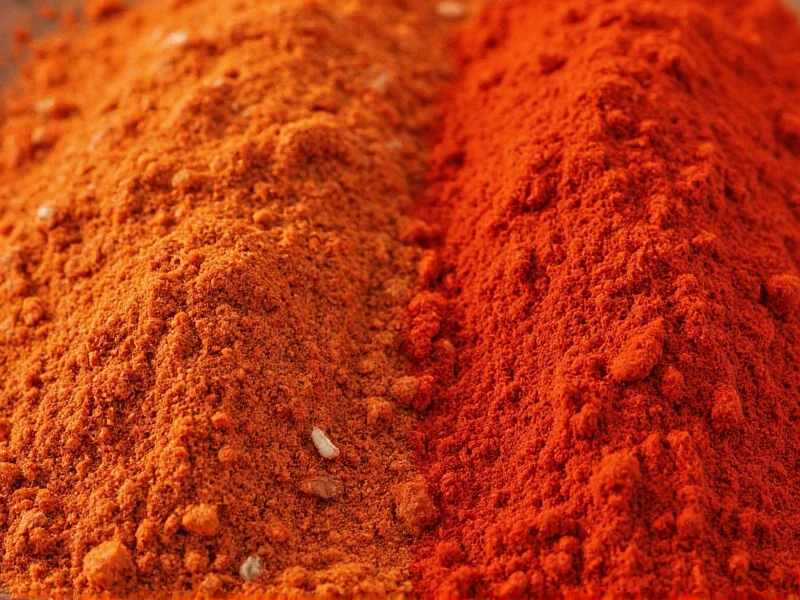Understanding the difference between cayenne and paprika is essential for home cooks and culinary professionals alike. These two red spices often sit side by side in pantries but serve distinctly different purposes in the kitchen. While both originate from Capsicum peppers, their processing methods, heat levels, and culinary applications vary significantly.
Origin and Production Methods
Cayenne pepper comes specifically from elongated, tapered cayenne peppers (Capsicum annuum) that are dried and ground into a fine powder. True cayenne maintains consistent heat because it's made from a single pepper variety. Paprika, however, is a broader category made from various sweet or hot peppers, primarily bell peppers and less pungent chili varieties. Hungarian and Spanish paprikas differ notably in production—Hungarian versions focus on flavor complexity while Spanish paprika often undergoes smoking over oak fires.
Heat Level Comparison
The most significant difference between cayenne and paprika lies in their Scoville Heat Units (SHU), which measure capsaicin concentration:
| Spice Type | Scoville Heat Units | Heat Perception |
|---|---|---|
| Cayenne Pepper | 30,000-50,000 SHU | Consistently hot with immediate burn |
| Sweet Paprika | 0-500 SHU | No heat, pure color and sweetness |
| Hot Paprika | 5,000-15,000 SHU | Moderate heat with complex flavor |
| Smoked Paprika | 100-2,500 SHU | Mild to medium heat with smoky notes |
When comparing cayenne vs paprika heat level, cayenne consistently delivers three to fifty times more heat than most paprika varieties. This dramatic difference explains why substituting one for the other without adjustment often leads to culinary disasters.
Flavor Profiles and Culinary Applications
Cayenne offers a straightforward, intense heat with subtle fruity undertones that quickly gives way to burning sensation. Chefs use it when pure heat is desired without competing flavors. Paprika provides more nuanced flavor experiences:
- Sweet paprika contributes vibrant red color and mild pepper flavor without heat—ideal for deviled eggs, potato salads, and finishing dishes
- Hot paprika delivers moderate heat with earthy, slightly sweet notes—perfect for Hungarian goulash and stews
- Smoked paprika (pimentón) adds deep smoky complexity—essential for Spanish chorizo, paella, and barbecue rubs
When considering when to use cayenne instead of paprika, remember that cayenne works best in dishes requiring significant heat without color contribution, while paprika excels when color and nuanced flavor matter as much as heat.
Nutritional Differences
Both spices contain capsaicinoids and carotenoids, but in different proportions. Cayenne contains higher concentrations of capsaicin, which research suggests may boost metabolism and reduce inflammation. Paprika, especially sweet varieties, contains higher levels of carotenoids like capsanthin that provide vibrant color and antioxidant benefits. A teaspoon of cayenne delivers approximately 1,300 IU of vitamin A compared to paprika's 2,600 IU, but cayenne contains more vitamin E and C by volume.
Substitution Guidelines
Understanding can I substitute paprika for cayenne (and vice versa) prevents recipe failures. When substituting:
- To replace cayenne with paprika: Use 3-4 times more hot paprika for equivalent heat, or add cayenne to sweet paprika
- To replace paprika with cayenne: Use 1/4 to 1/2 teaspoon cayenne for every tablespoon of paprika, plus tomato paste for color
- For smoked paprika substitution: Add a drop of liquid smoke to cayenne or regular paprika
Is paprika as hot as cayenne? Generally no—even hot paprika rarely matches cayenne's consistent heat level. The exception is specialty hot paprikas from regions like Calabria, which approach lower-range cayenne heat.
Storage and Shelf Life
Both spices lose potency over time but require similar storage conditions. Keep both in airtight containers away from light and heat. Properly stored:
- Cayenne maintains peak heat for 1-2 years
- Sweet paprika retains vibrant color for 1 year
- Smoked paprika preserves smoky flavor for 6-12 months
Test potency by rubbing a small amount between fingers—fresh cayenne should produce immediate warmth, while quality paprika should release aromatic oils without bitterness.
Common Misconceptions
Several myths persist about these spices. Many believe cayenne and paprika are interchangeable, but their different heat levels make direct substitution problematic. Others confuse paprika with generic "red pepper flakes" which contain seeds and membranes creating different heat profiles. Understanding cayenne pepper benefits compared to paprika reveals they serve complementary rather than identical purposes in cuisine.
Practical Usage Tips
Add cayenne early in cooking for integrated heat that mellows, or at the end for sharper kick. Incorporate paprika early to develop flavor complexity, especially smoked varieties which need time to bloom in oil. When working with either spice, remember that fat helps distribute capsaicin evenly—always bloom in oil rather than adding directly to liquids.











 浙公网安备
33010002000092号
浙公网安备
33010002000092号 浙B2-20120091-4
浙B2-20120091-4